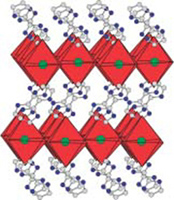Faculty Profile
 Arnold Guloy
Arnold Guloy
Moores Professor
Department of Chemistry
Office: SERC, 5021
Contact: aguloy@uh.edu - 713-743-2792
Education: Ph.D., Iowa State University, 1991; B.S., University of the Philippines, 1985
IBM Postdoctoral Fellow, IBM TJ Watson Research Center, 1992-1993
Our research can be described as syntheses and characterization of crystalline solid materials with novel structures and unique properties. Our group has embarked on exploring three relatively uncharted areas, namely; a) crystalline organic-inorganic hybrid compounds, b) polar intermetallics and Zintl phases, and c) soluble Zintl anions.
The synthesis and characterization of crystalline organic-inorganic hybrid materials is motivated by the expectation that one can modulate and design crystalline hybrid materials that combine (synergism) or enhance properties associated with the functional inorganic and organic components. These organic-inorganic crystalline materials exhibit tunable properties associated with the structural and electronic 'flexibility' of the inorganic and organic moieties. The remarkable materials offer useful model systems for understanding the chemistry and physics of low-dimensional materials, particularly their electronic, optical and superconducting properties.
 A virtual gold mine of remarkable stoichiometries, unprecedented structures, novel
chemical bonding, and potential functional materials is to be found through synthetic
explorations of polar intermetallics and Zintl phases. The underdeveloped chemistry
of intermetallics and their unpredictable phase stabilities offers a serious challenge
to solid state chemists. Our work on intermetallics, using careful synthesis and characterization,
and the application of viable theoretical models, is part of the overall attempt to
understand the structure-property-chemical bonding relationships in solid materials.
A virtual gold mine of remarkable stoichiometries, unprecedented structures, novel
chemical bonding, and potential functional materials is to be found through synthetic
explorations of polar intermetallics and Zintl phases. The underdeveloped chemistry
of intermetallics and their unpredictable phase stabilities offers a serious challenge
to solid state chemists. Our work on intermetallics, using careful synthesis and characterization,
and the application of viable theoretical models, is part of the overall attempt to
understand the structure-property-chemical bonding relationships in solid materials.
The polar intermetallic examples we have discovered among the silicides and post transition metals (Ge, Sn, Pb, Ga, especially In) range from normal Zintl phases to "unsaturated" inorganic p-systems such as isolated cyclopropenium-analog [In3]5- trimer, infinite chains of allyl-like [In=In-Ge]6- anions, and [Ni(Si3)]4- metallocene-like polymers. Moreover, we have obtained other complex polar intermetallics that feature oligomers to metallic sheets that behave as two-dimensional metals, and novel three-dimensional anion networks. Our investigations also involve the reactivity of Zintl phases - chemistry of soluble Zintl anions. This is motivated by our aim to develop viable chemical routes to the growth of molecular 'bare' clusters to large semiconductor clusters and well-defined nanophases. The reactivity of soluble Zintl phases has provided well-crystallized materials that feature polyhedral Ge92- anion clusters, oligomers as well as the unprecedented polymeric [Ge9]2- anion.
- 2015: Moores Professorship, University of Houston
- 2015: Visiting Professor, Sun Yat-Sen University, CHINA
- 2009: Distinguished Visiting Scholar-Lecturer Award, Chungnam National University, Daejun, KOREA
- 2009: Award for Excellence in Research and Scholarship (Professor Level), University of Houston
- 2008 – 2009: Distinguished Visiting Professor, Institute of Chemistry, University of the Philippines, Diliman, PHILIPPINES
- 2004 – 2010: Guest Scientist/Visiting Professor Max-Planck-Institute for Chemical Physics of Solids, Dresden, GERMANY
- 2004: Amando Clemente Memorial Award, University of the Philippines Chemistry Alumni Foundation, PHILIPPINES
- 1998: Early Faculty CAREER Award, National Science Foundation, USA
- 1997: Visiting Scientist Award, Department of Science and Technology-Exchange Scientist and Engineer Program, PHILIPPINES
- 1997: Award for Excellence in Research and Scholarship (Assistant Professor Level), University of Houston, 1997